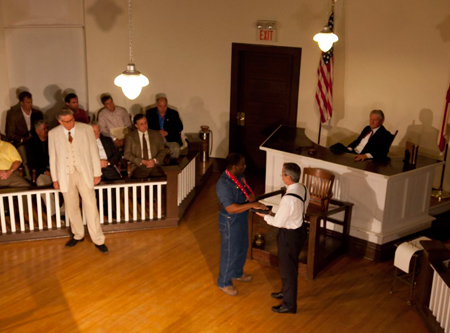Literature Links: To Kill a Mockingbird
Harper Lee’s To Kill a Mockingbird is one of the selections in the Books That Shaped America online exhibition. The curator’s note reads:
This 1960 Pulitzer Prize winner was an immediate critical and financial success for its author, with more than 30 million copies in print to date. Harper Lee created one of the most enduring and heroic characters in all of American literature in Atticus Finch, the small-town lawyer who defended a wrongly accused black man. The book’s importance was recognized by the 1961 Washington Post reviewer: “A hundred pounds of sermons on tolerance, or an equal measure of invective deploring the lack of it, will weigh far less in the scale of enlightenment than a mere eighteen ounces of new fiction bearing the title To Kill a Mockingbird.”
If your students read this influential American novel, below are some ideas for incorporating primary sources from the Library of Congress into your novel study unit.
From Megan Kohlman, a Library Media Specialist at Augusta High School in Augusta, Kansas.
Overview
This lesson was designed to help ninth grade students build background knowledge, particularly on the topic of segregation and race relations in the South, before reading the novel To Kill a Mockingbird. I started the lesson by having students recall what they know about segregation. Their answers were fairly basic, ideas like “it’s a separation” and “it’s usually race or gender based.”
Activity Resources
Paper Primary Source Analysis Tool
Digital Primary Source Analysis Tool
Teacher Guides for Analyzing Primary Sources
Examples of Jim Crow laws American RadioWorks
Political cartoons
- For the sunny South. An airship with a “Jim Crow” trailer 1913 political cartoon
- Inch by Inch 1960 political cartoon curator description
- I’m eight 1962 political cartoon curator description
Personal histories from American RadioWorks
Photographs
- Negro drinking at “Colored” water cooler in streetcar terminal 1939 Oklahoma City, Oklahoma
- Negro going in colored entrance of movie house on Saturday afternoon 1939 Belzoni, Mississippi Delta, Mississippi
- A drinking fountain 1943 Bethlehem-Fairfield shipyards, Baltimore, Maryland
Activity Flow
- I explained to students what a primary source is and went through the steps for Analyzing Primary Sources using the Library’s Primary Source Analysis Tool.
- We looked at a few examples of Jim Crow laws, then I modeled a primary source analysis using the 1913 political cartoon.
- I divided the class into four groups, which enabled students to bounce ideas and thoughts off each other as well as opportunities to disagree about pieces and what was going on in the sources and what was important.
- Each group met at a station with a number of resources of the same type (political cartoons, images, personal histories, examples of laws), blank copies of the primary source analysis tool and a copy of the corresponding Teacher’s Guide. The guides really helped students get the conversation going.
- Each group chose one primary source to start with, and analyzed it together. After about 10 minutes, they rotated, having a turn at each station. Ten minutes was a good start for the students, but it would have been wonderful to have more time, at least 15 minutes, for them to really delve in.
Activity Reflection
The novel study teacher, Ms. Julie Barker, said, “The lesson Mrs. Kohlman taught to my Freshman English students was significant in jump starting their interest in and understanding of the historical background for To Kill a Mockingbird. The students were able to view and read primary sources from the time of segregation and interact, question, and struggle with the history in a hands-on environment rather than a sit-and-get lecture environment. Many students had very little background knowledge of the time period and were shocked at some of the events they read about. If it hadn’t been for the primary sources and Mrs. Kohlman’s guidance, they may not have believed the information. Students were then very eager to start reading the book, which is unusual for freshmen.”
From Kathleen Prody & Nicolet Whearty via the Library of Congress Lesson Plans page.
Students gain a sense of the living history that surrounds the novel To Kill a Mockingbird. Through studying primary source materials from the Library of Congress and other online resources, students of all backgrounds may better grasp how historical events and human forces have shaped relationships between black and white, and rich and poor cultures of our country.
This unit guides students on a journey through the Depression Era in the 1930s. Activities familiarize the students with Southern experiences through the study of the novel and African American experiences through the examination of primary sources.
- Historical Understanding of Setting
- Exploring Oral History
- Writing Connection
- Getting into the Novel
- Mob Justice
- Pulling it all Together
Examining Social Justice Through Historical, Classic and Contemporary Sources
This lesson from Kasey Short, an eighth-grade English teacher at Charlotte Country Day school in North Carolina, provides students with historical perspective and showcases contemporary voices of people wrongly accused and those who helped the accused prove their innocence.
Comparing Text Scenes with Play Scenes
Use this set of images from scenes from the play “To Kill A Mockingbird”, performed in Monroeville, Alabama in 2010, to investigate how scenes from the text were interpreted on stage.
The Importance of Literature
Read how the U.S. House of Representatives and U.S. Senate paid homage to Harper Lee’s novel.
- H.Res.1525 July 26, 2010
- S.Res.614 August 5, 2010

